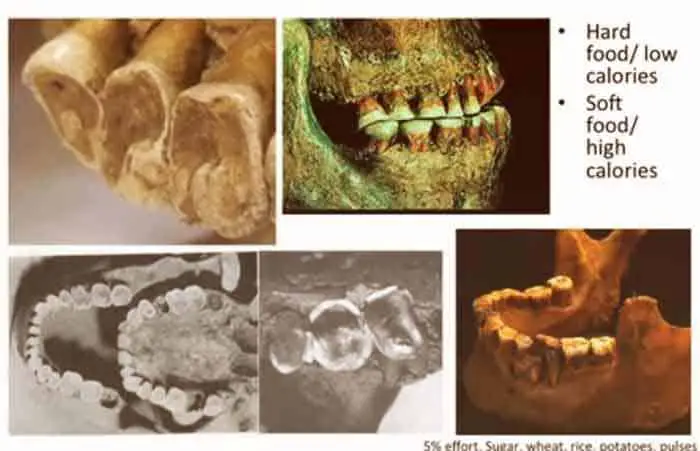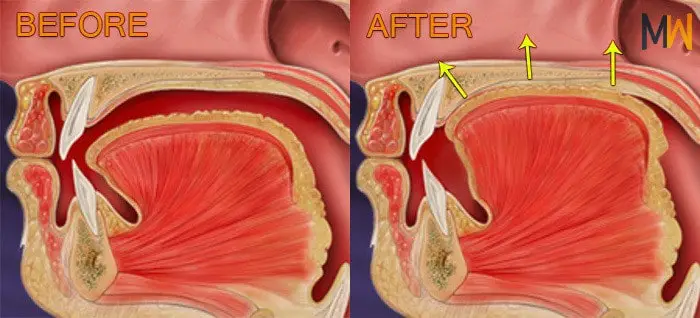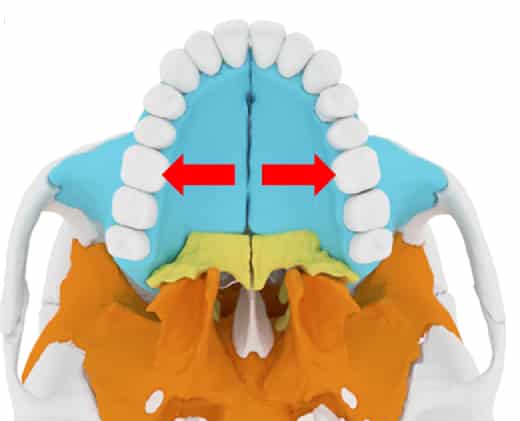
Everyone who knows the basics of mewing knows that you need to rest your tongue on your palate. But not everyone has a normal-sized palate.
If your tongue doesn’t fit in your palate, then your palate is too small. It can make it difficult or nearly impossible for you to mew. It could come from your genetics, eating soft foods, and improper tongue posture. You will need medical intervention, such as palatal expanders.
Why Does My Tongue Not Fit in My Palate?
One reason why people have small palates could be their genetics. If your parents have small palates, you probably got it from them.
However, the biggest reason is your environment. Ancient humans did not have narrow palates. They had wide spacious jaws with room for all their teeth. The phenomenon of palates too small for our mouths has arisen only recently due to the lack of hard foods in our diet and poor oral posture stemming from mouthbreathing.
Prolonged Improper Tongue Posture
If you have improper tongue posture, particularly during your childhood, for a long time, then your palate will be narrow. That is because your tongue does not put pressure on your palate. Therefore, it does not get a chance to expand. Your cheek muscles will literally squish your mouth inwards unless your tongue fights back.
Mouth Breathing
Mouth breathing could also be another factor. When you breathe from your mouth, you are doing the exact opposite of mewing – overly relaxed and open jaw and mouth, improper tongue posture, no pressure to your palate, etc.
You have to find the cause of your mouth breathing habits, and if it’s something like allergies, get the appropriate medical treatment.

Soft Diets and Lack of Chewing
Due to lifestyle changes, our eating habits change. Many of us choose diets full of soft, processed foods because they are easier to eat. Studies show that diet hardness affects the maxilla. Diets that don’t require lots of chewing hurt maxillary growth.
For instance, a study was done on rats to see how a soft diet and a hard diet affects their maxilla (Yamamoto et al., 1996). The rats on a soft liquid diet got smaller palates. Therefore, different food consistencies can affect the palate’s size.
Tongue pressure is also associated with an increase in children’s masticatory performance (Fujita et al., 2018). Therefore, a lack of chewing because of soft diets and improper tongue posture can lead to narrow palates.
Another example would be hunter-gatherers from hundreds of years ago. Many hunters did not need braces. They had a hard diet, which required proper tongue posture and more chewing. That pressure and proper tongue posture created a larger mandible and wider palate.
Mewing
If your palate is only slightly narrow, then you could try to mew to expand it. Many people said that they had to force themselves to mew, and they were able to expand their palate, eventually creating enough room on their palate for their tongue.
It would be best if you were consistent when you apply pressure to your palate. Consistency is the key to mewing.
You may notice that it is significantly more comfortable for you to mew after mewing for some time because your palate might have expanded. Some people state that they expanded their palate with mewing after a few months to a year. However, age is the biggest factor here. As an adult, it’s going to be difficult and take years.

You also ought to make sure that you focus on your technique. You must apply pressure to your palate in the right places.
To learn more about mewing and how to perfect your technique, see our guide.
However, you need to make sure that you do not touch your teeth. If you put pressure on your teeth, they may become crooked.
Reposition Your Tongue
If possible, you can “reshape” your tongue to fit in your palate. You can try to “thicken” your tongue vertically to make it a bit smaller. That way, you can comfortably rest it on your palate without touching your teeth.
However, keep in mind that you should not force your tongue up on your palate if it hurts. If you reshape your tongue, but it still hurts your tongue, you should find another way to expand your palate like a palate expander.
Palate Expanders
In some cases, your palate might be so narrow that you cannot mew at all. Even if you squish your tongue and try your best, it may not work, and you might still touch your teeth.
Therefore, the next best step would be to get a palate expander. A palate expander is a device put on your palate to expand it. Most people wear palate expanders for 6-12 months. An orthodontist may have to leave it in for another few months to let the new bone form.

The palate expander works by separating the two halves of your maxilla. It separates it where the two halves get joined, which is the midpalatal suture. You may get a key to turn the screw every day to help expand your palate.
As the halves separate, the suture opens and widens your palate. New bone should form at the suture. Bones heal pretty fast, unlike with mewing, where you’re just trying to get bones to remodel (an insanely slow process).
It would be best if you never took out a palate expander too early. You could experience a relapse to the original palate size when the new bone does not form.
You can consult an orthodontist to see what kind of palate expander you need. The typical types include:
- Rapid Palatal Expander (RPE)
- Removable Palatal Expander
- Implant-Supported Expansion
- Surgically Assisted Palatal Expansion
Similar to mewing, children see the quickest results from palatal expanders. Most children can get them removed in as quickly as three months, depending on their case. If you only need a minor expansion, then you can opt for a removable palate expander.
However, adults can also use palatal expanders; they merely need to get the right one. For instance, mature adolescents may need to use implant-supported expanders because they need more force to separate the two maxilla halves.
If your jaw has reached its full size, an orthodontist may suggest a surgically assisted palatal expander. Your orthodontist will make an incision in the midpalatal suture and then insert your expander afterward.

